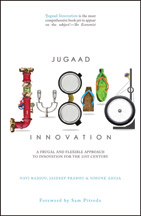The first question that I have in mind whenever I hear the word Jugaad Innovation is if it is Innovation. Or is it just a workaround way to get things done when the resources are limited or when stuck in an unexpected situation? The best answer that I have managed to find is that Jugaad is not innovation. But the situations in which people resort to Jugaad have some clues to how some of the characteristics can be used by organizations to be more innovative. The era of large R&D and Marketing spends is coming to an end. So to work with limited resources or save resources wherever you can is going to be the new mantra. And Jugaad philosophy falls on the same lines. That is why it suddenly becomes important now. And is being widely written about though it has existed forever in countries like India.
Authors have deconstructed Jugaad Innovation into six principles:
- Seek Opportunity in Adversity
- Do more with less
- Think & Act Flexibly
- Keep it Simple
- Include the Margin
- Follow your heart
The only one I completely agree with is Think & Act Flexibly. Because you cannot do innovation without these two things – Jugaad or Otherwise. In my opinion, Jugaad is a response to an urgent need, when the actual or usual solution is not available in the vicinity. And you somehow make things work. Jugaad as a term does not apply to regular solutions. But too situational solutions when the regular solution is missing. Examples quoted by authors are from large organizations that continue to spend lots of money on R&D.
There are some well-known examples of reverse innovations that companies like GE have engaged in. Basically giving the basic product for a fraction of the price instead of a full featured product for a full price. Similarly calling the 3Ms innovations Jugaad is something that I could not relate to. Giving it the name of Jugaad is force fitting the example. If I look at the principles to only No 3 applies. Everything else is driven by the dynamics of the market the companies are trying to capture. Though I believe that the next wave of marketing campaigns and deal designs would be Simplicity. And hence the principle of ‘Keep it Simple’ will work well.
The chapter on ‘Integrating Jugaad into your Organization’ is the best chapter of the book. And if you cannot read the whole book, read this one. It tells you that Jugaad is a not a solution in every situation. And then tries to help you with situations where it is and where it is not a good option. In fact like everything else, you have to know what Jugaad is and use it when and where you feel it is applicable. The last Chapter on ‘Building Jugaad Nations’ introduces you to many initiatives across the globe that according to authors are Jugaad innovations. Irrespective of how you classify these programs, they are worth knowing about. They are good networks that you can plug into for new innovations for your organization.
Ironically the first person mentioned in this book Prof Anil Gupta who introduced authors to some grassroots’ innovators in India recently expressed his dislike for calling Jugaad an Innovation when he mentioned this on his FB status: I am very happy to see Finance Minister echoing my sentiment, “Jugaad is not innovation. It is a very corrupt way of looking at innovation. We are quite adept at getting things done. But what we really need is to appreciate and reward genuine innovation.” I agree.
Authors have been writing about Jugaad Innovations on HBR Blog for quite some time now. If you read that blog you would have read the book Jugaad Innovation there more or less.
You may this book – Jugaad Innovation: A Frugal and Flexible Approach to Innovation for the 21st Century by Navi Radjou, Jaideep Prabhu, Simone Ahuja at Amazon.










i must make some jugaad to have this book to understand jugaad theory 😛
have a nice day!